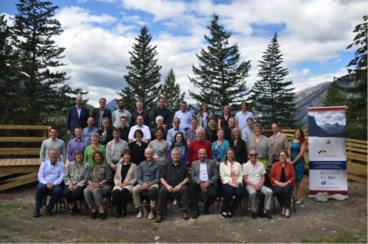Making Connections at Banff
October 27, 2015 • By Markus Höfner and Amelia Thomson-DeVeaux
What do longevity research and new media have in common? Can we draw meaningful connections between a study of Gandhi’s ashrams and an analysis of human migration patterns? And what on earth is the difference between a bear and a hoodoo?
These were some of the questions that emerged from a two-week residency seminar, held this summer in the heart of the Canadian Rockies, to mark the beginning of an innovative new exploration into the enhancement of life. The Enhancing Life Project, funded by the John Templeton Foundation and supported by a transatlantic cooperation between the University of Chicago in the United States and Ruhr-University Bochum in Germany, is driven by a simple yet fundamental query: How, in an age of unprecedented human power and vulnerability, can life continue to be enhanced?
There are, of course, countless ways to begin to answer this question—whether it’s by looking to history, medicine, theology, philosophy, political science, or business. But the goal of the Enhancing Life Project is even more ambitious. By supporting the work of 35 scholars, who gathered for the first time at the Banff Center in Banff, Alberta, Canada, the Project began to pull together the threads of these different disciplines to create an entirely new strand of scholarly inquiry. This diverse group of 15 prominent Advanced Career Scholars and 20 promising Early Career Scholars began, in Banff, to make connections between different disciplines, research topics, and viewpoints – and to ask how these different perspectives can contribute to the enhancement of life.

The residency, which offered both a focused topic and ample time for discussion, kicked off an exciting collaborative journey into an emerging field. The 35 scholars of The Enhancing Life Project come from disparate backgrounds—Christian theology, religious studies (including Jewish, Muslim, Hindu, Buddhist, and Confucian thought), anthropology, business, communications, history, law, media studies, medicine, philosophy, political science, social work, and sociology--and from different countries and cultural contexts, including Germany, Iraq, Israel, Taiwan, the United Kingdom, and the USA. Their individual research projects range from “The Vortex of Expectations” (on longevity research) to “Enhancing Connectivity” (on media technologies) and from “Gandhi's Ashrams: Residential Experiments for Enhancing Life in India and South Africa” to “Promised Lands and Scattered Tribes: Spiritual Aspirations in Modern Mass Migration.” (Check out the full list of scholars and projects here.)
Breathing in the fresh air at Banff, scholars began to take a fresh look at their own fields, asking questions like: What does my research say about how we can strategically enhance life? How could such strategies fail or succeed, and what are the stakes? By probing and engaging, the scholars at the Banff residency found common ground and began to lay the foundation for new research into Enhancing Life Studies.
Connecting ideas is impossible without connecting people. Through shared meals, hikes, and late-night conversations in Banff, the scholars began to create an atmosphere of trust and shared curiosity. To make sure the discussions weren’t limited to the ivory tower, six non-academic interlocutors with backgrounds in art, ministry, science, and journalism arrived, armed with questions about the public relevance of each proposal. “The Enhancing Life Project has particular importance in providing a thoughtful, multidisciplinary context for a range of global public policy agendas,” says Ronne Hartfield, the former Executive Director of Museum Education for the Art Institute of Chicago and one of the six interlocutors.

As the scholars departed, they made plans to work together over the coming months on groundbreaking, cross-disciplinary research—some of which will be chronicled on this blog. The collaborative nature of the Enhancing Life Project is crucial, because only one of the questions mentioned in the beginning has yet to find a definitive answer: as the city-dwellers now know, a bear can run quite fast (hopefully away from you), while a hoodoo is a soaring stone structure found in the Canadian Rockies.
There are no bears and no hoodoos in Berlin, Germany, but planning for the next residency seminar near Berlin in summer 2016 is already underway. “Each of the residency seminars is held within an environment which, when taken together, forms the context for thinking about enhancing life from multiple perspectives,“ says William Schweiker, an Enhancing Life Project co-leader and a professor of theological ethics at the University of Chicago. “The Banff seminar alerted us to the complexity of natural environments and the enhancing of life. When we meet in Berlin, a global city with a long and exceedingly complex history, then political and social realities will provide a background to our thinking.“
